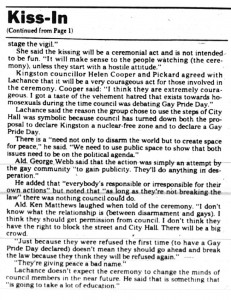Period : After 1950 Audio Player
On August 8, 1985, the front page of the Kingston Whig-Standard blazed with the headline “Gay Anti-nuke kiss-in idea shocks city mayor”. Kiss-in organizer Francois Lachance explained to the paper that the 15-minute ceremony would make clear the connections between the anti-nuclear movement and the gay movement. Organizers of the three-day vigil to mark the bombing of Hiroshima and Nagasaki were glad of the addition of the kissing ceremony to their other events, but, as the Whig noted, Mayor John Gerretson and several aldermen “couldn’t see what an exchange of kisses between homosexuals had to do with disarmament”.
Despite complaints that they were “giving peace a bad name”, the ceremony went ahead on August 9 with a speech from Lachance on the steps of City Hall and then a 5-second embrace and kiss between Philip MacDougall and Ford Barker. The crowd reacted with applause and a few boos. Not only did the ceremony attract a crowd of 400 onlookers, but photos of the kiss were printed on the Whig’s front page. In a follow-up article, the paper described it as “a kiss that reverberated throughout Kingston”, and community responses ranged from appreciation, to fascination, to outrage.
The paper’s August 9 editorial cartoon seems to encapsulate some of the more hostile responses. It depicted an airplane labelled the “Enola Gay Pride” dropping a bomb marked “AIDS”, and in one of the letters in a half-page spread published in the paper about the event, the Rev. C.G. Votary made the same link, writing that “[h]omosexuals and lesbians kissing each other in public are the products of sick minds and emotions; disarmament by North America in the face of the ideologies of communist Russia is also the product of sick minds and emotions.” The paper reported that the picture had angered “most Whig readers” and that two people had cancelled their subscriptions and “a number of others” had given the paper “a piece of their minds”. One woman commented that the photo made her “feel like throwing up”, a man insinuated that “a ‘new fruit belt’ has developed at the head of the St. Lawrence”, and a group of tourists who had witnessed the ceremony commented that it had spoiled their tour of Kingston’s stately buildings. They conceded that homosexuals “may have their rights,” but they complained, “why advertise it?”
The men who performed the kiss received telephoned death threats as well as facing criticism in the paper, but as the Whig of August 13 reports, they did not regret their actions. The paper reports that MacDougall “believes the kiss-in was a good idea because physical displays of affection show peaceful co-operation rather than competition between men.” A letter to the Whig recalled the anti-Vietnam war slogan “make love not war”, commenting that “for men it is more difficult to love, to be gentle and peaceful. All men, whether they be gay or straight, are afraid of being labelled ‘queer’ and so help to maintain all levels of aggression.”
Although critics of the ceremony seem to have been more common, or at least more vocal, than supporters, the discussion sparked by this very visible event may have had positive effects. Lachance commented that the large crowd of curious onlookers was a “healthy sign” because “that’s how one teaches”.







